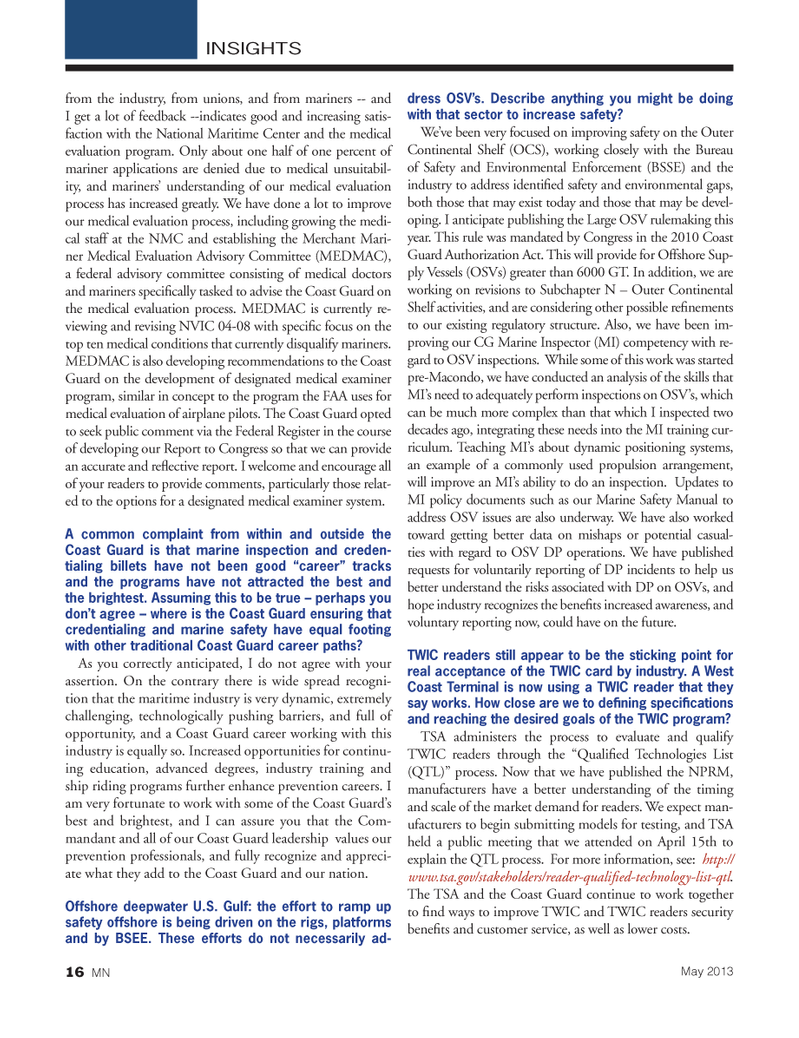
Page 16: of Marine News Magazine (May 2013)
Combat & Patrol Craft Annual
Read this page in Pdf, Flash or Html5 edition of May 2013 Marine News Magazine
from the industry, from unions, and from mariners -- and I get a lot of feedback --indicates good and increasing satis- faction with the National Maritime Center and the medical evaluation program. Only about one half of one percent of mariner applications are denied due to medical unsuitabil- ity, and mariners? understanding of our medical evaluation process has increased greatly. We have done a lot to improve our medical evaluation process, including growing the medi- cal staff at the NMC and establishing the Merchant Mari- ner Medical Evaluation Advisory Committee (MEDMAC), a federal advisory committee consisting of medical doctors and mariners speci cally tasked to advise the Coast Guard on the medical evaluation process. MEDMAC is currently re- viewing and revising NVIC 04-08 with speci c focus on the top ten medical conditions that currently disqualify mariners. MEDMAC is also developing recommendations to the Coast Guard on the development of designated medical examiner program, similar in concept to the program the FAA uses for medical evaluation of airplane pilots. The Coast Guard opted to seek public comment via the Federal Register in the course of developing our Report to Congress so that we can provide an accurate and re ective report. I welcome and encourage all of your readers to provide comments, particularly those relat- ed to the options for a designated medical examiner system. A common complaint from within and outside the Coast Guard is that marine inspection and creden- tialing billets have not been good ?career? tracks and the programs have not attracted the best and the brightest. Assuming this to be true ? perhaps you don?t agree ? where is the Coast Guard ensuring that credentialing and marine safety have equal footing with other traditional Coast Guard career paths? As you correctly anticipated, I do not agree with your assertion. On the contrary there is wide spread recogni- tion that the maritime industry is very dynamic, extremely challenging, technologically pushing barriers, and full of opportunity, and a Coast Guard career working with this industry is equally so. Increased opportunities for continu- ing education, advanced degrees, industry training and ship riding programs further enhance prevention careers. I am very fortunate to work with some of the Coast Guard?s best and brightest, and I can assure you that the Com- mandant and all of our Coast Guard leadership values our prevention professionals, and fully recognize and appreci- ate what they add to the Coast Guard and our nation. Offshore deepwater U.S. Gulf: the effort to ramp up safety offshore is being driven on the rigs, platforms and by BSEE. These efforts do not necessarily ad- dress OSV?s. Describe anything you might be doing with that sector to increase safety? We?ve been very focused on improving safety on the Outer Continental Shelf (OCS), working closely with the Bureau of Safety and Environmental Enforcement (BSSE) and the industry to address identi ed safety and environmental gaps, both those that may exist today and those that may be devel- oping. I anticipate publishing the Large OSV rulemaking this year. This rule was mandated by Congress in the 2010 Coast Guard Authorization Act. This will provide for Offshore Sup- ply Vessels (OSVs) greater than 6000 GT. In addition, we are working on revisions to Subchapter N ? Outer Continental Shelf activities, and are considering other possible re nements to our existing regulatory structure. Also, we have been im- proving our CG Marine Inspector (MI) competency with re- gard to OSV inspections. While some of this work was started pre-Macondo, we have conducted an analysis of the skills that MI?s need to adequately perform inspections on OSV?s, which can be much more complex than that which I inspected two decades ago, integrating these needs into the MI training cur-riculum. Teaching MI?s about dynamic positioning systems, an example of a commonly used propulsion arrangement, will improve an MI?s ability to do an inspection. Updates to MI policy documents such as our Marine Safety Manual to address OSV issues are also underway. We have also worked toward getting better data on mishaps or potential casual- ties with regard to OSV DP operations. We have published requests for voluntarily reporting of DP incidents to help us better understand the risks associated with DP on OSVs, and hope industry recognizes the bene ts increased awareness, and voluntary reporting now, could have on the future. TWIC readers still appear to be the sticking point for real acceptance of the TWIC card by industry. A West Coast Terminal is now using a TWIC reader that they say works. How close are we to de ning speci cations and reaching the desired goals of the TWIC program? TSA administers the process to evaluate and qualify TWIC readers through the ?Quali ed Technologies List (QTL)? process. Now that we have published the NPRM, manufacturers have a better understanding of the timing and scale of the market demand for readers. We expect man- ufacturers to begin submitting models for testing, and TSA held a public meeting that we attended on April 15th to explain the QTL process. For more information, see: http://www.tsa.gov/stakeholders/reader-qualiÞ ed-technology-list-qtl . The TSA and the Coast Guard continue to work together to nd ways to improve TWIC and TWIC readers security bene ts and customer service, as well as lower costs. INSIGHTS16 MNMay 2013MN May2013 Layout 1-17.indd 16MN May2013 Layout 1-17.indd 165/3/2013 12:49:50 PM5/3/2013 12:49:50 PM

 15
15

 17
17
